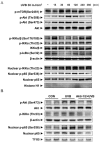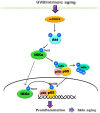The underlying mechanism of proinflammatory NF-κB activation by the mTORC2/Akt/IKKα pathway during skin aging
- PMID: 27486771
- PMCID: PMC5288141
- DOI: 10.18632/oncotarget.10943
The underlying mechanism of proinflammatory NF-κB activation by the mTORC2/Akt/IKKα pathway during skin aging
Abstract
Mammalian target of rapamycin complex 2 (mTORC2), one of two different enzymatic complexes of mTOR, regulates a diverse set of substrates including Akt. mTOR pathway is one of well-known mediators of aging process, however, its role in skin aging has not been determined. Skin aging can be induced by physical age and ultraviolet (UV) irradiation which are intrinsic and extrinsic factors, respectively. Here, we report increased mTORC2 pathway in intrinsic and photo-induced skin aging, which is implicated in the activation of nuclear factor-κB (NF-κB). UVB-irradiated or aged mice skin revealed that mTORC2 activity and its component, rictor were significantly upregulated which in turn increased Akt activation and Akt-dependent IκB kinase α (IKKα) phosphorylation at Thr23 in vivo. We also confirmed that UVB induced the mTORC2/Akt/IKKα signaling pathway with HaCaT human normal keratinocytes. The increased mTORC2 signaling pathway during skin aging were associated to NF-κB activation. Suppression of mTORC2 activity by the treatment of a mTOR small inhibitor or knockdown of RICTOR partially rescued UVB-induced NF-κB activation through the downregulation of Akt/IKKα activity. Our data demonstrated the upregulation of mTORC2 pathway in intrinsic and photo-induced skin aging and its role in IKKα/NF-κB activation. These data not only expanded the functions of mTOR to skin aging but also revealed the therapeutic potential of inhibiting mTORC2 in ameliorating both intrinsic skin aging and photoaging.
Keywords: Gerotarget; NF-κB; UV; mTORC2; skin aging.
Conflict of interest statement
The authors have no conflict of interest to declare.
Figures





References
-
- Vellai T, Takacs-Vellai K, Zhang Y, Kovacs AL, Orosz L, Muller F. Genetics: influence of TOR kinase on lifespan in C. elegans. Nature. 2003;426:620. - PubMed
-
- Berneburg M, Plettenberg H, Krutmann J. Photoaging of human skin. Photodermatology, photoimmunology & photomedicine. 2000;16:239–244. - PubMed
-
- Martin DE, Hall MN. The expanding TOR signaling network. Curr Opin Cell Biol. 2005;17:158–166. - PubMed
-
- Sarbassov DD, Guertin DA, Ali SM, Sabatini DM. Phosphorylation and regulation of Akt/PKB by the rictor-mTOR complex. Science. 2005;307:1098–1101. - PubMed
MeSH terms
Substances
LinkOut - more resources
Full Text Sources
Other Literature Sources
Medical
Molecular Biology Databases
Miscellaneous

